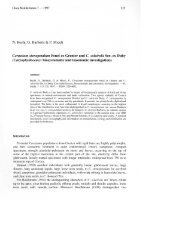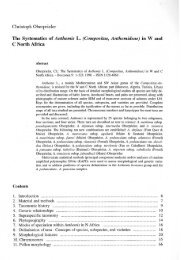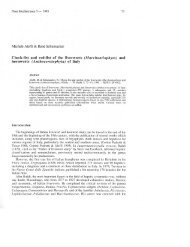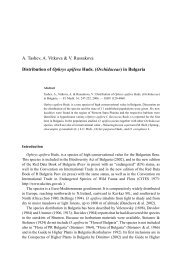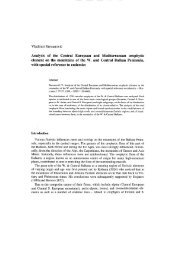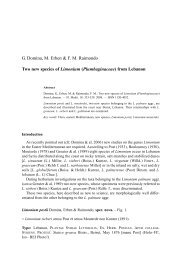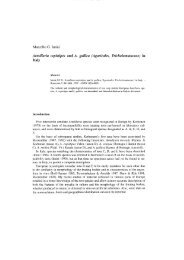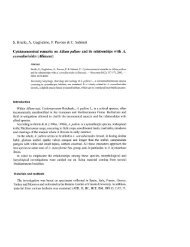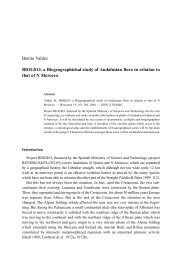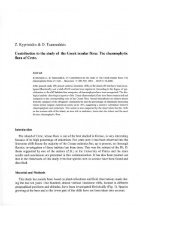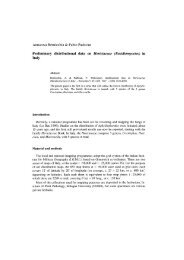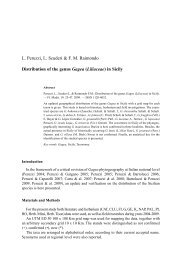Maria Rosa Fernández Calzado & Joaquín Molero ... - Herbmedit.org
Maria Rosa Fernández Calzado & Joaquín Molero ... - Herbmedit.org
Maria Rosa Fernández Calzado & Joaquín Molero ... - Herbmedit.org
You also want an ePaper? Increase the reach of your titles
YUMPU automatically turns print PDFs into web optimized ePapers that Google loves.
248 <strong>Fernández</strong> <strong>Calzado</strong> & <strong>Molero</strong> Mesa: High altitude flora of Sierra Nevada (Spain)<br />
rior relevance, compared to lowland regions; (3) the majority of vascular plants are slowgrowing<br />
and long-lived perennials, thus, are expected to indicate impacts of a continued climate<br />
change rather than effects of short-term climate oscillations (Pauli & al. 1999).<br />
Nowadays, the consequences of climatic change on mountain plants have already been<br />
recognised: upward range expansions, increase on species richness, extinctions, etc<br />
(Erschbamer & al., 2009; Grabherr & al., 1994, 2010; Holzinger & al., 2008; Klanderud<br />
& Birks, 2003; Vittoz & al., 2008). Therefore, in order to protect the flora, it is important<br />
to know in detail its current situation in the mountain areas which might be threatened by<br />
the effects of global warming. This is the case of Sierra Nevada (southern Spain), an outstanding<br />
massif in the Mediterranean region detected as a vulnerable biodiversity hotspot<br />
in the Mediterranean basin (<strong>Fernández</strong>-González & al. 2005; Médail & Quézel 1997,<br />
1999). The importance of the massif, characterised by an exceptional concentration of<br />
endemic taxa on its higher summits (Blanca & <strong>Molero</strong> Mesa 1990; Blanca & al. 1998;<br />
Rivas-Martínez & al. 1991), is well documented in the context of national and international<br />
biodiversity (Blanca 1996; <strong>Molero</strong> Mesa & Pérez Raya 1987; <strong>Molero</strong> Mesa & al.<br />
1996; Myers 2000; Quézel 1953; Rivas Goday & Mayor López 1966). The current projections<br />
on changes in temperatures and precipitation conditions on the Iberian Peninsula,<br />
where Sierra Nevada is located, threaten its flora and endanger its biodiversity (<strong>Fernández</strong>-<br />
González & al. 2005). Therefore, we consider this study to be a very useful research as it<br />
contributes to a current and detailed analysis about the highest mountain flora of Sierra<br />
Nevada, information that could be used in the future as a testimony for variations that<br />
might be provoked by climatic change.<br />
Methods<br />
Study area.- The Sierra Nevada massif is part of the Baetic Cordillera in the southern<br />
part of Spain and stretches over about 90 km in west-east direction (Fig. 1). Its altitude<br />
exceeds the rest of Baetic Cordillera by 1100 m, with numerous summits above 3000 m<br />
a.s.l., including the highest peak on the Iberian Peninsula (Mulhacen, 3481m).<br />
The study area coincides with the limits of the upper vegetation belt, called the cryoromediterranean<br />
belt by Rivas-Martínez (1981, 2007). This area only covers 38,8 km 2<br />
with its lower boundaries oscillating between 2750 m, on northern and western slopes and<br />
3290 m on southern and eastern (<strong>Fernández</strong> <strong>Calzado</strong> 2007; <strong>Molero</strong> Mesa & al. 2009). The<br />
limit of the lower vegetation belt, oromediterranean, is approximately between 1900-2200<br />
m (Valle & al. 2003).<br />
Its bedrock composition consists mainly of highly weathered feldspar and graphitic<br />
mica schist (Gómez Ortiz & al. 2009). The landscape includes steep slopes, scree and<br />
rocky areas that were partly shaped by Pleistocene glaciers.<br />
Biogeographically speaking, the area belongs to the Nevadense sector of the Baetic<br />
province of the Mediterranean region (Rivas-Martínez 2007). Unlike elsewhere in Europe,<br />
several species of the study area are shared with the High Atlas range (Morocco).<br />
From a bioclimatic point of view, Sierra Nevada is exposed to a Mediterranean bioclimate<br />
in its pluviseasonal oceanic variant (Rivas-Martínez 2007). There is a pronounced summer<br />
drought at all altitudes and above 2500 m precipitation falls almost exclusively as snow.



